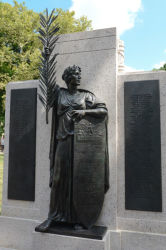Saratoga Park
Saratoga Park War Memorial
Who does this monument honor and how was it created?
In 1920 the Citizen’s Memorial Committee of Districts 31 and 32 commissioned Italian American sculptor James Novelli (1885-1940) to create this monument honoring the heroic dead from the neighborhood who had given their lives in combat during World War I. Novelli created a bronze allegorical female figure holding a palm frond, and supporting a shield—symbols of peace and war. It was cast by Roman Bronze Works, a Brooklyn fine art foundry. The relief was installed on a 9’6”-high stele, with two flanking stones of Milford pink granite, to which were attached bronze honor rolls listing the servicemen who had paid the supreme sacrifice. The monument was dedicated in 1921 and cost $5,500.
On September 24, 1970 the honor rolls were reported stolen, and on April 20, 2000 the sculpture was stolen. A police investigation helped recover numerous pieces of the sculpture at local scrap yards. In 2013-14 a capital project recreated the long missing bronze honor rolls and sculpture based on historical photographs and reference to recovered remnants. The pedestal was reset on a new concrete foundation, centrally located, and this historic memorial was restored to its former glory as an object of local civic pride and remembrance.
Who created this monument?
James Novelli was born in Sulmona, a province of Aquila, Italy in 1885. His family settled in New York when he was five years old, and at an early age he impressed his teachers at PS 23 with his natural artistic skill. Novelli returned to Italy in 1903 to study, and while a student, earned an honorable mention for his artwork submitted to the International Exposition in Paris, France in 1906. He graduated from the Royal Academy of Rome in 1908.
Returning to New York, where he resided at West 23rd Street in Manhattan, Novelli was much in demand as a sculptor of funereal and public monuments. Besides this monument he also created the Clason Point War Memorial (1928) in the Bronx, the Winfield War Memorial (1926), Queens, and bronze mausoleum doors in Calvary Cemetery (1923) for which he won the Henry O. Avery Prize for sculpture. In the 1930s Novelli worked on the Parks Department’s monuments crew, and even helped to make repairs on his Saratoga War Memorial in 1937. However, during the Great Depression, his own artistic career languished, and growing increasingly despondent, Novelli tragically took his own life in 1940.
Check out your park's Vital Signs
Clean & Safe
Green & Resilient
Empowered & Engaged Users
Share your feedback or learn more about how this park is part of a
Vital Park System






